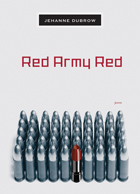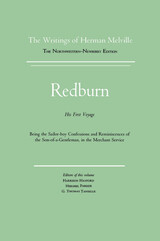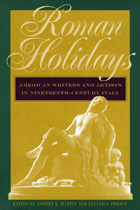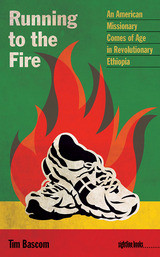127 books about Americans and 4
start with R
127 books about Americans and 4
127 books about Americans
4 start with R start with R
4 start with R start with R

Red Army Red
Poems
Jehanne Dubrow
Northwestern University Press, 2012
Displaying a sure sense of craft and a sharp facility for linking personal experience to the public realms of history and politics, Jehanne Dubrow’s Red Army Red chronicles the coming of age of a child of American diplomats in Eastern Europe in the 1980s. In the last moments of the Cold War, Poland—the setting for many of the poems—lurches fitfully from a society characterized by hardship and deprivation toward a free-market economy. The contradictions and turmoil generated by this transition are the context in which an adolescent girl awakens to her sexuality. With wit and subtlety, Dubrow makes apparent the parallels between the body and the body politic, between the fulfillment of individual and collective desires.
[more]

Redburn
Works of Herman Melville Volume Four
Herman Melville
Northwestern University Press, 1969
Redburn is a fictional narrative of a boy's first voyage, based loosely on Melville's own first voyage to and from Liverpool in 1839. Hastily composed and little esteemed by its author, Redburn was more highly thought of by his critics, who saw it regaining the ground of popular sea stories like Typee and Omoo.
Melville so disliked the novel that he submitted it to his publisher without polishing it. This scholarly edition corrects a number of errors that have persisted in subsequent editions. Based on collations of the editions published during his lifetime, it incorporates corrections made in the English edition and emendations made by the present editors.
As with all the books in the Northwestern-Newberry series, this edition of Redburn is an Approved Text of the Center for Editions of American Authors (Modern Language Association of America).
Melville so disliked the novel that he submitted it to his publisher without polishing it. This scholarly edition corrects a number of errors that have persisted in subsequent editions. Based on collations of the editions published during his lifetime, it incorporates corrections made in the English edition and emendations made by the present editors.
As with all the books in the Northwestern-Newberry series, this edition of Redburn is an Approved Text of the Center for Editions of American Authors (Modern Language Association of America).
[more]

Roman Holidays
American Writers and Artists in Nineteenth-Century Italy
Robert K. Martin
University of Iowa Press, 2001
Featuring essays by twelve prominent American literature scholars, Roman Holidaysexplores the tradition of American travel to Italy and makes a significant contribution to the understanding of nineteenth-century American encounters with Italian culture and, more specifically, with Rome.
The increase in American travel to Italy during the nineteenth century was partly a product of improved conditions of travel. As suggested in the title, Italy served nineteenth-century writers and artists as a kind of laboratory site for encountering Others and “other” kinds of experience. No doubt Italy offered a place of holiday—a momentary escape from the familiar—but the journey to Rome, a place urging upon the visitor a new and more complex sense of history, also forced a reexamination of oneself and one's identity. Writers and artists found their religious, political, and sexual assumptions challenged.
Nathaniel Hawthorne's The Marble Faun has a prominent place in this collection: as Henry James commented in his study of Hawthorne, the book was “part of the intellectual equipment of the Anglo-Saxon visitor to Rome.” The essayists also examine works by James, Fuller, Melville, Douglass, Howells, and other writers as well as such sculptors as Hiram Powers, William Wetmore Story, and Harriet Hosmer.
Bringing contemporary concerns about gender, race, and class to bear upon nineteenth-century texts, Roman Holidays is an especially timely contribution to nineteenth-century American studies.
[more]

Running to the Fire
An American Missionary Comes of Age in Revolutionary Ethiopia
Tim Bascom
University of Iowa Press, 2015
In the streets of Addis Ababa in 1977, shop-front posters illustrate Uncle Sam being strangled by an Ethiopian revolutionary, parliamentary leaders are executed, student protesters are gunned down, and Christian mission converts are targeted as imperialistic sympathizers. Into this world arrives sixteen-year-old Tim Bascom, whose missionary parents have brought their family from a small town in Kansas straight into Colonel Mengistu’s Marxist “Red Terror.” Here they plan to work alongside a tiny remnant of western missionaries who trust that God will somehow keep them safe.
Running to the Fire focuses on the turbulent year the Bascom family experienced upon traveling into revolutionary Ethiopia. The teenage Bascom finds a paradoxical exhilaration in living so close to constant danger. At boarding school in Addis Ababa, where dorm parents demand morning devotions and forbid dancing, Bascom bonds with other youth due to a shared sense of threat. He falls in love for the first time, but the young couple is soon separated by the politics that affect all their lives. Across the country, missionaries are being held under house arrest while communist cadres seize their hospitals and schools. A friend’s father is imprisoned as a suspected CIA agent; another is killed by raiding Somalis.
Throughout, the teenaged Bascom struggles with his faith and his role within the conflict as a white American Christian missionary’s child. Reflecting back as an adult, he explores the historical, cultural, and religious contexts that led to this conflict, even though in doing so he is forced to ask himself questions that are easier left alone. Why, he wonders, did he find such strange fulfillment in being young and idealistic in the middle of what was essentially a kind of holy war?
Running to the Fire focuses on the turbulent year the Bascom family experienced upon traveling into revolutionary Ethiopia. The teenage Bascom finds a paradoxical exhilaration in living so close to constant danger. At boarding school in Addis Ababa, where dorm parents demand morning devotions and forbid dancing, Bascom bonds with other youth due to a shared sense of threat. He falls in love for the first time, but the young couple is soon separated by the politics that affect all their lives. Across the country, missionaries are being held under house arrest while communist cadres seize their hospitals and schools. A friend’s father is imprisoned as a suspected CIA agent; another is killed by raiding Somalis.
Throughout, the teenaged Bascom struggles with his faith and his role within the conflict as a white American Christian missionary’s child. Reflecting back as an adult, he explores the historical, cultural, and religious contexts that led to this conflict, even though in doing so he is forced to ask himself questions that are easier left alone. Why, he wonders, did he find such strange fulfillment in being young and idealistic in the middle of what was essentially a kind of holy war?
[more]
READERS
Browse our collection.
PUBLISHERS
See BiblioVault's publisher services.
STUDENT SERVICES
Files for college accessibility offices.
UChicago Accessibility Resources
home | accessibility | search | about | contact us
BiblioVault ® 2001 - 2024
The University of Chicago Press









